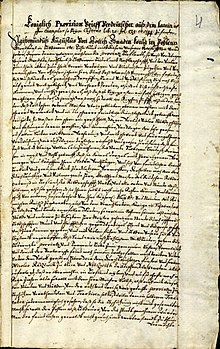
Back Віленская унія Byelorussian Віленская унія BE-X-OLD Union von Wilna German Tratado de Vilna Spanish Vilno leping (1561) Estonian Traité de Vilnius (1561) French Trattato di Vilnius (1561) Italian Viļņas ūnija Latvian/Lettish Pakt wileński Polish Tratado de Vilnius (1561) Portuguese

The Treaty of Vilnius or Vilna was concluded on 28 November 1561, during the Livonian War, between the Livonian Confederation and the Grand Duchy of Lithuania in Vilnius. With the treaty, the non-Danish and non-Swedish part of Livonia, with the exception of the Free imperial city of Riga, subjected itself to the Grand Duke of Lithuania, Sigismund II Augustus with the Pacta subiectionis (Provisio ducalis). In turn, Sigismund granted protection from the Tsardom of Russia and confirmed the Livonian estates' traditional privileges, laid out in the Privilegium Sigismundi Augusti.
The secularization of the Livonian Order was the "final act"[1] in Livonia's transition from the Middle Ages to the Early Modern era. The territories were re-organized in the Duchy of Courland and Semigallia and the Duchy of Livonia, the latter competing with the Kingdom of Livonia during the war. After its reconquest, Sigismund's successor Stephen Báthory (Batory) ignored the privileges of 1561, granted a new constitution and initiated counter-reformation. These measures were reversed after the Swedish conquest. When after a further series of wars Livonia capitulated to Russia in 1710, the Privilegium Sigismundi Augusti was confirmed by Peter the Great.
- ^ Frost (2000), p. 5
© MMXXIII Rich X Search. We shall prevail. All rights reserved. Rich X Search